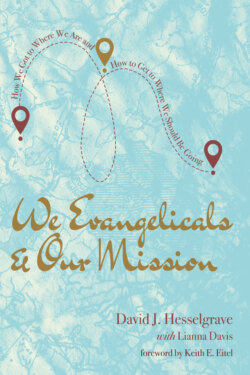Читать книгу We Evangelicals and Our Mission - Lianna Davis - Страница 10
На сайте Литреса книга снята с продажи.
ОглавлениеPart I: Evangelicals and the Great Tradition of Christian Thinking
A decade or so ago, Trinity Evangelical Divinity School (TEDS) published a Festschrift in honor of church historian John D. Woodbridge entitled The Great Commission: Evangelicals and the History of World Missions.1 In the Festschrift, Trinity’s associate professor of church history and the history of Christian thought, Douglas A. Sweeney, provides several definitions of “evangelical” as offered by scholars of other schools and backgrounds. He then offers a stipulated definition of his own. Each of the definitions/descriptions has something to commend it, but in this book, I prefer to adopt and adapt Sweeney’s definition because it is grounded in church and mission history. He says,
I prefer to describe evangelicalism with more specificity as a movement that is based on classical Christian orthodoxy, shaped by a Reformational understanding of the gospel, and distinguished from other such movements in the history of the church by a set of beliefs and behaviors forged in the fires of the eighteenth-century revivals—the so-called “Great Awakening” . . . —beliefs and behaviors that had mainly to do with the spread of the gospel abroad.2
I agree. I believe that the “stakes,” “tethers,” and “cords” of classical orthodoxy; the Reformation understanding of the gospel; and Great Awakening beliefs and behaviors including missions/missiology reflect what the evangelical movement and its mission should be if it is to have a future (Figure 1). It goes without saying that I cannot do justice to the whole of that history. I probably will not do justice to all that Sweeney has in mind, and for that I apologize. I ask the reader to think of what follows in Part I as no more than a series of snapshots of the history involved and to do his or her own study to fill in the gaps of which there will be many.
Figure 1. Three sources of Evangelicalism
Of the many references that undergird Part I, a little book on the great tradition coauthored by David Dockery and Timothy George and published by Crossway has been most helpful to my purpose.3 Of the words used in the title of that book the one most likely to give pause to some readers is the word “tradition.” However, Dockery and George quote the Methodist scholar Thomas Oden, who says, “All that is meant by tradition, then, is the faithful handing down from generation to generation of scripture interpretation consensually received worldwide and cross-culturally through two millennia.”4 Oden’s phraseology is worth pondering—“scripture interpretation,” “consensually received,” “worldwide and cross-culturally,” “handed down through two millennia.” That is precisely what we are attempting to discover here, and it is not only good, it is “essential to evangelicalism.”
1. Sweeney, “Introduction.” See also, Sweeney, American Evangelical Story, 82.
2. Sweeney, “Introduction,” 2.
3. Dockery and George, Great Tradition.
4. Oden, Rebirth of Orthodoxy, 32.
